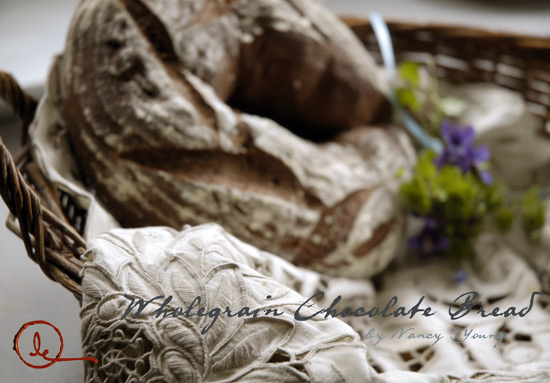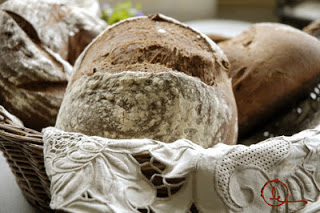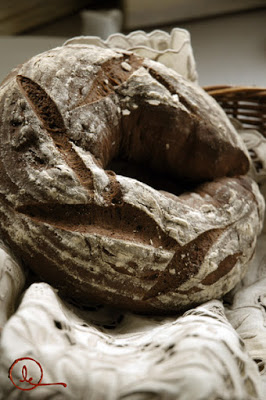Wholegrain chocolate bread
By Nancy Young
 |
| Photographs by Elspeth Young |
Cocoa is the powder derived from the cocoa bean. The bean is derived from the cocoa tree. The cocoa tree was apparently derived from the Garden of Eden virtually unscathed, but obviously lonely. It waited patiently, however, for its derived powder to be joined with some pleasing fat, so it could again become a celestial food—which is now known as chocolate, and which I indulge in whenever I get the chance.
This bread resulted a few days ago from a combination of the need to use up an aging orange coupled with the need to devour chocolate. Addictions will tell.
It's remarkably quick, fortunately, to get from desire to satisfaction with this bread—for a yeast bread, at least—and it's also a very adaptable bread. It's wholegrain to make me feel better about the butter and sugar—but the sugar can be halved and so can the butter—why, I don't know, but they can. The entire recipe can be halved, in fact, since I concocted it to work in my very large KitchenAid stand mixer, and then it can be made in a smaller stand mixer or a large food processor. (Bread makers offend my delicate bread-and-chocolate sensibilities so I can't tell you about them.) And, of course, for the intrepid, the recipe's not too bad by hand, either. (I'm guessing that, I don't actually know, however, since, while I'm not lazy enough to use a bread maker, I'm plenty lazy enough to use a stand mixer.)
I've made it without salt (on purpose, actually, sometimes I make salt-free bread without it being on purpose) for a low-sodium friend, and have on discerning authority that it works in its salt-free form as well. And you can use refined sugar instead of the unrefined.
Since it's quick and has sugar, it does suffer a bit from the resultant flavor of a hefty dose of yeast—but the yeast can be reduced to a scant teaspoon if you have chocolate in another form to fall back on and can wait 6 hours or so for its first rise. Happy baking!
Ingredients:
2 cups warm milk
1 cup lightly warmed orange juice or water
1 tablespoon dried yeast
3 tablespoons molasses
1/2 cup unrefined cane sugar
grated rind on 1 large orange
1/2 cup unsweetened cocoa powder
1/2 cup unsalted butter, softened
1 tablespoon salt
6 or more cups whole wheat flour
Egg Wash (optional)
Place the milk and water in the bowl of a large, heavy-duty mixer, sprinkle with the yeast and add the molasses. Stir lightly and allow it to rest until the yeast has proofed--about five minutes (it's a good time to grate the orange peel). Add the sugar, orange peel, cocoa, butter and salt, and place the bowl under the dough hook and stir just enough to get them thinking about each other on good terms. Add the flour, stir lightly and let the dough hook do its magic for a minute or two. If the dough is slack, begin adding flour 1/2 cup at a time allowing about 30 seconds of mixing after each addition. Since it's never going to clean the bowl until it's too stiff, check the dough for doneness after each addition by snagging about a tablespoonful of dough and rolling it between your palms for a few seconds--if it's still sticky, add more flour. If it cleans up nicely, you're done adding flour and can let the dough hook work for about another 3 to 5 minutes; but if you're of the must-knead-it-myself-for-awhile-to-feel-I-really-made-it ilk—this is a very satisfying dough for hand kneading, silky and responsive.
 The first rise will be surprisingly quick for such a rich dough--probably around an hour. Once risen (and scaled and benched and all that good stuff if you like to do it—and I do), the shape can be happily free form. This full recipe makes 4 pounds of dough—enough for four small loaves, three large loaves or two fat loaves. Rolls will vary but 4 dozen should be about right. I shape it into rounds or oblongs and toss it into bannetons, but it can be made into rolls, fat rounds or long baguettes and placed on silicone- or parchment-covered baking sheets, or simply cuddled down into regular loaf pans. The second rise will, naturally, be quicker than the first—about 35 to 45 minutes, so I generally start preheating the ovens as soon as the bread's shaped—especially since I use a baking stone. Preheat the oven to 375 degrees, and once the bread is doubled it can be popped out of the bannetons, if using, or left contentedly in place, if not, and slashed with a lame, a razor or a good serrated knife—again, in any old way you like best. (I like the handsome design the floured-banneton leaves on this loaf, so I don't brush it with egg wash, but for non-banneton rolls and loaves, egg wash lends a wonderfully dark, glossy edge to the baked loaves.) Once the loaves are safely in the oven, turn down the heat to 350 degrees.
The first rise will be surprisingly quick for such a rich dough--probably around an hour. Once risen (and scaled and benched and all that good stuff if you like to do it—and I do), the shape can be happily free form. This full recipe makes 4 pounds of dough—enough for four small loaves, three large loaves or two fat loaves. Rolls will vary but 4 dozen should be about right. I shape it into rounds or oblongs and toss it into bannetons, but it can be made into rolls, fat rounds or long baguettes and placed on silicone- or parchment-covered baking sheets, or simply cuddled down into regular loaf pans. The second rise will, naturally, be quicker than the first—about 35 to 45 minutes, so I generally start preheating the ovens as soon as the bread's shaped—especially since I use a baking stone. Preheat the oven to 375 degrees, and once the bread is doubled it can be popped out of the bannetons, if using, or left contentedly in place, if not, and slashed with a lame, a razor or a good serrated knife—again, in any old way you like best. (I like the handsome design the floured-banneton leaves on this loaf, so I don't brush it with egg wash, but for non-banneton rolls and loaves, egg wash lends a wonderfully dark, glossy edge to the baked loaves.) Once the loaves are safely in the oven, turn down the heat to 350 degrees.Bake until rolls or loaves test clean and have non-wimpy bottom crusts ( obviously roll and loaf size will make a great difference)—but start checking at about 20 minutes for rolls and 35 minutes for all but very large loaves. Cool on wire racks, and if at all possible take a nice piece slathered with unsalted butter or marmalade to a quiet corner and pretend you're making sure that it's good enough for the rest of the family to eat. If it's not, you'll be forced to consume the loaves all by yourself.
Tags: 2013, Recipes by Nancy Young
Browse articles by year: 2025 . 2024 . 2023 . 2022 . 2021 . 2020 . 2019 . 2018 . 2017 . 2016 . 2015 . 2014 . 2013 . 2012 . 2011 . 2010 . 2009 . 2008 . 2007 . 2006 . 2005 . 2004 . 2003 . 2002 . 2001 . 2000 . 1999 . 1998 . 1997 . 1996
Browse articles by topic: Art lessons . BenHaven Archives . Blank art diaries . Fine art photography . Framing . Illustration . Inspiration and creativity . Isles of Rune . Limited Editions Collection . My Fathers Captivity . News . Novellas . Oil paintings and prints . Operations announcements . Orders and shipping . Overview . Portfolios . The Papers of Seymore Wainscott . Project commentaries . Recipes by Nancy Young . Recommended reading . Recommended viewing . Temple artworks . The Storybook Home Journal . Tips and techniques . Tools supplies and operations
Browse articles by topic: Art lessons . BenHaven Archives . Blank art diaries . Fine art photography . Framing . Illustration . Inspiration and creativity . Isles of Rune . Limited Editions Collection . My Fathers Captivity . News . Novellas . Oil paintings and prints . Operations announcements . Orders and shipping . Overview . Portfolios . The Papers of Seymore Wainscott . Project commentaries . Recipes by Nancy Young . Recommended reading . Recommended viewing . Temple artworks . The Storybook Home Journal . Tips and techniques . Tools supplies and operations
